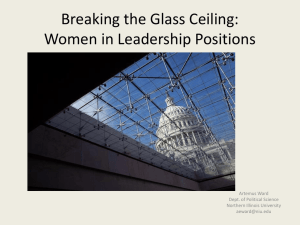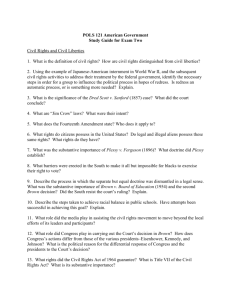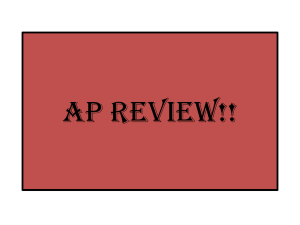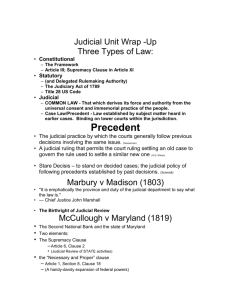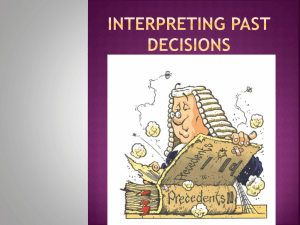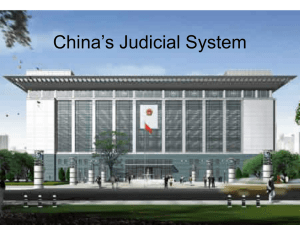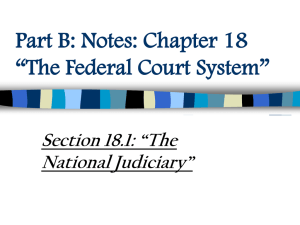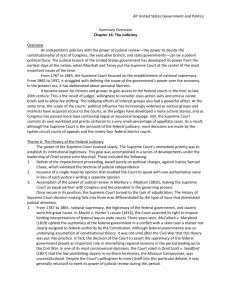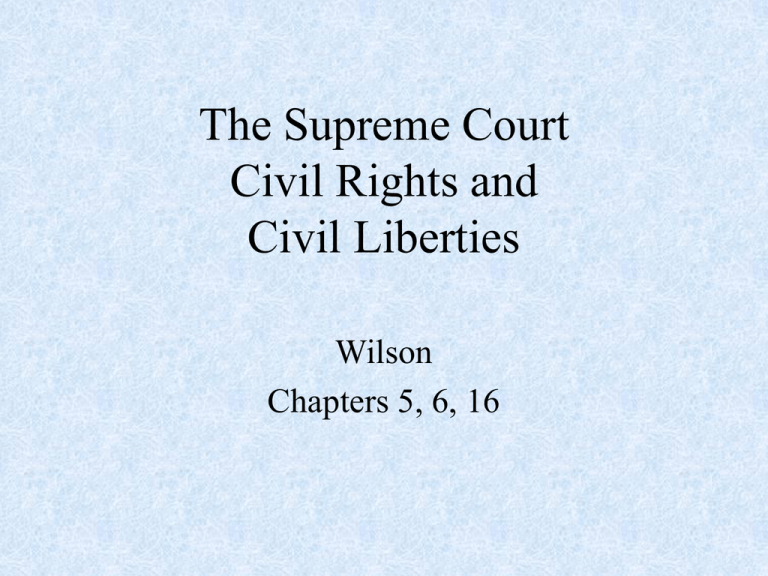
The Supreme Court
Civil Rights and
Civil Liberties
Wilson
Chapters 5, 6, 16
The Supreme Court
•
The Court’s power comes from “judicial review”
based on the case of Marbury v Madison
• Actually, only a few countries have judicial review
including Australia, Canada, Germany & India
• How to interpret the Constitution????
1. Strict constructionist – judges are bound by the
exact wording of the Constitution
2. Activist – judges should look at the underlying
principles behind the Constitution
* Judges can be either conservative or liberal
Quick history
•
The Founding Fathers probably expected judicial
review but also probably never thought about the
huge role it would play in policy-making
• Three eras of background:
1. National supremacy and slavery (1789-1861)
- Madison and McCulloch, commerce issues, Dred
Scott, federal government over states
2. Government and economy (1865-1936)
- 14th Amendment and private property, role of
business and government, Plessy and segregation
A bit more…
3. Government and liberty (1936-present)
- shift of attention to personal liberty, Warren court
very active, revival of state power
Structure of courts
• Power found in Article III of Constitution
• Constitutional courts, Legislative courts handle
cases that the Supreme Court doesn’t
• Judges are appointed and then approved by Senate
• Senate more likely to approve judges picked from
senators home state!! (Senatorial Courtesy)
• The “litmus test” – test of ideological purity, in other
words, does the judge poses the same political ideals
as the president who appoints them…
All of the Courts
1. District courts – civil and criminal cases involving
federal law
2. Courts of Appeal – hears appeals from federal
courts and regulatory agencies (EPA)
3. Supreme Court – appeals from state and federal
courts
* Courts of appeal created in 1891 to relieve pressure
on Supreme Court
Route to the Supreme Court
• Court handles both original and appellate
jurisdiction – straight to court or through appeals
• Rule of four – at least 4 judges must agree to have
Court hear case
• Writ of certiorari – an order to a lower court to
send up a record in a given case
• Certificate – when lower courts request a ruling on
a particular point of law only!
The Court at work
1. Oral arguments – lawyers emphasize the major
points of their case
2. Briefs – written documents supporting one side of
a case
3. Solicitor General – represents the US Government
in cases where the government is involved (Nixon)
4. Conference – judges meet in secret to discuss case
5. Opinions – justices write opinions, there may also
be concurring opinions and dissenting opinions –
all may have influence on future cases!!!!
(Precedent)
Rule of Precedent
• Precedent of “free speech”
1. Schenk v US (1919) – he spoke against the draft in
WWI – NOT protected speech because it created a
“clear and present danger” to the recruiting of
troops in war time!
2. Whitney v California (1927) – tried to create a
Communist Labor Party, convicted by state based
on “clear and present danger” test and upheld by
the Supreme Court but one concurring opinion
stated that “mere fear of ideas is not enough to
stop them, ideas need to be discussed first”
Rule of Precedent continued
3. Dennis v United States (1951) – Dennis was a
leader of the Communist Party and violated Smith
Act – can’t advocate overthrowing the US gov –
upheld and clarified “clear and present danger” by
defining the “gravity of the evil” being said
justifies violating free speech.
4. Yates v United States (1957) – Yates and other
members of Communist Party BUT their
conviction of violating Smith Act was overturned –
merely stating an idea is different that taking
action on the idea
Finally!!
5. Brandenburg v Ohio (1969) – Brandenburg, a
KKK member, called for a rally and potential
violence and was arrested BUT his conviction
overturned and established “imminent lawless
action” test –
Was the speech calling for immediate violent
action and did people respond immediately to it?
No…
Overturned Whitney and even changed “clear and
present danger” based on 1) intent 2) imminence
and 3) likelihood of action being taken…
Power of the Court
• Power to make policy – by interpretation of the
Constitution or by extending existing law
• Has declared 160 laws unconstitutional and
overturned 260 cases
• Some support judicial activism to correct injustices
of government, courts are last resort for some people
• Some oppose judicial activism because judges lack
expertise in situations, balancing priorities, and
courts are not accountable because judges not
elected…
Civil Liberties and Civil Rights
• Civil liberties are our protections against
government action
• They are guaranteed by the Bill of Rights
• Civil rights are positive acts taken by the
government to make civil liberties a reality
• Examples include Supreme Court cases and acts of
Congress including the Civil Rights Act of 1964
Civil Liberties handout
Civil Liberties
• What protects Supreme Court justices from politics? What
shields them?
1. serve life terms
2. appointed, not elected
3. don’t have to answer to anyone
• How does a Supreme Court Justice make their decision?
1. the Constitution
2. other laws
3. precedent
Loose Constructionist
I
Implied language
I
Judicial Activism
(uses their own views
and beliefs – the
Spirit of the Law)
Strict Constructionist
I
Expressed language
I
Judicial Restraint
(the Letter of the Law)
• Example: What about our right to privacy?
• No where in the Constitution does it say we
have that right. It’s unwritten law – Common
Law from England. “A man’s home is his
castle. But if that’s true, how come the
government can take that castle by means of
eminent domain.
• Our right to privacy is “implied”. It’s a
penumbra, an attachment or implication.
•
•
•
•
Religion and the Government
Government encourages religion – tax breaks,
chaplains in the military
Religion in life – swear on a Bible, oath of
offices, ceremonies open with prayers,
National Anthem and coins and money
reference God
Establishment Clause – separation of church
and state
Free Exercise Clause – free to believe what
you want, but not act as you want
• The “Wall of Separation” is cloudy at best!!
• School Prayer – Engle v. Vital said no prayers in school,
even if voluntary.
• Abington School District v. Schempp said no Bible reading
• Wallace v. Jaffree said no moment of silence
• But the court said that public schools cannot sponsor
religious exercises, but doesn’t say that individuals can’t
pray when and as they please, nor did the court say that
students cannot study the Bible in a literary or historical
context. And despite the court’s decisions, many schools
still have organized prayer and Bible study in classrooms!!
• According to the Equal Access Act of 1984 says that
students can have religious groups as long as they meet the
same terms as any other group on campus.
So what about aid to religious schools?
• They must pass the “Lemon Test”.
1. the purpose of the aid must be secular, not religious
2. primary effect neither enhances or inhibits religion
3. avoids an excessive entanglement of government and
religion
Came from Lemon v. Kurtzman in which it didn’t allow
“reimbursements” to private schools for salaries, books, etc.
• The courts get around the religious issues:
• Buses for religious schools based on safety issues
• Interpreters for deaf kids for educational purposes
• Loaning of equipment for educational purposes
• Tax credits
• But religious issues are more than just in schools…
• Seasonal displays have been removed but not if
there are other nonreligious displays, or if it’s just a
Christmas tree.
• And how far can “free exercise” go???
• Well, in Reynolds v. US, the Court said that
polygamy was illegal (endangers women). In Bunn
v. North Carolina, using poisonous snakes was
illegal in religious services (gee, imagine that??),
can’t use drugs as part of religious ceremony,
Oregon v. Smith.
• Even “bizarre” religious ceremonies can be
protected such as one in Florida that used animal
sacrifices in their ceremonies.
Rights are relative…
• Remember, your rights are not absolute
• That means that each person’s rights are relative to
the rights of every other person – the right to swing
my fist ends at the other person’s nose
• Example: we all have free speech but not absolute
free speech
• What of obscene language?
• What about words that cause a person to commit a
crime or desert the military?
• What about libel or slander?
Let’s talk obscenity (porn?)
• First of all, even the Supreme Court can’t define it
• Justice said “I know what it looks like but can’t put
it into words”
• 1973 Miller v. California – stated that if the
obscenity in question “appeals to the prurient
interest” – in other words, elicits lust…
• Also, if the work is “lacking serious literary, artistic,
political or scientific value”
• Local restrictions usually include zoning laws – to
restrict location of adult entertainment
Crime and due process
• Please remember the 14th Amendment – it deals with
due process under the law
• Exclusionary rule – evidence taken in violation of
the Constitution cannot be used in court
• Don’t forget role of Mapp and Miranda and Gideon
• Terrorism has created a whole new set of issues
regarding search and seizure
• Also remember that evidence that is clearly visible
is NOT protected by the exclusionary rule!!!
Speech and Press
• Libel is written statement defaming another person
• Slander is an oral statement against another person
• Neither is protected except some libel and slander is
worse than others… levels of speech
• Public figures must show statements made with
“actual malice” – reckless disregard for the truth
• NO prior restraint on the press
• Symbolic speech not protected if it violates a law
(burning a draft card) but states can’t make certain
types of symbolic speech illegal (flag burning)
Civil Rights
• The text chapter really focuses on the civil rights of
African-Americans and women
• Sit-ins and freedom rides – went from the nonviolent movement to the “long, hot summers” of
racial violence 1964-1968
• Five bills pass including the Civil Rights Bill of
1964 and Voting Rights Bill of 1965 and others
• Has all helped lead to a dramatic rise in political
participation among African-Americans and a
change in “white elite opinion”
More Civil Rights…
• When a group is being denied access to facilities,
opportunities or services available to other groups it
is a violation of their “civil rights”
• Remember Brown v Board of Education
• Mecklenburg case set guidelines for schools
• Issue of busing… remember Boston from last year?
• Rights of women and gender based discrimination
including employment, military, Little League,
abortion (Roe case and others)
• Sexual harassment and a hostile environment
Other rights…
• Affirmative action – also known as preferential
hiring practices, to give less fortunate a chance
• Bakke case – race can’t be part of hiring or
admissions process
• Gay rights – Court has overturned state rules
regarding sexual activity between same sex couples
• Gay marriage is the issue du jour – allowed in some
states
• Private groups, like the Boy Scouts, can still exclude
homosexuals


